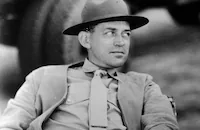Laughing Boy

Brief Synopsis
Cast & Crew
W. S. Van Dyke
Ramon Novarro
Lupe Velez
William Davidson
Chief Thunderbird
Catalina Rambula
Film Details
Technical Specs

Synopsis
Newly arrived to the southern section of the Navajo nation, Laughing Boy, an expert silversmith, attends the annual Great Sing Dance at T'si Lani and there meets the beautiful Slim Girl. Reared by whites, the orphan Slim Girl, whose "town" name is Lily, is ostracized by the conservative Navajos and is denounced as a prostitute. Although confused by Slim Girl's overtly seductive behavior, Laughing Boy is nonetheless drawn to her and is goaded by her to compete in a horse race. During the race, for which Laughing Boy has offered his most coveted bracelet as a prize, Red Man, a Pauite, causes Laughing Boy's horse to fall. Laughing Boy loses the race but, determined to win back his bracelet and impress Slim Girl, immediately challenges Red Man to a wrestling match. After Laughing Boy defeats Red Man in the match, he confesses his love to an admiring Slim Girl. Although his strict father refuses to sanction a union with Slim Girl, Laughing Boy leaves with her that night. While camping, Slim Girl seduces the inexperienced Laughing Boy with "moonshine" and flirtation, but finds herself alone the next morning, abandoned by the now-ashamed Navajo. Crushed, Slim Girl returns to her shabby life as mistress to George Hartshone, a brutish but well-to-do rancher. Soon, however, her yearning for Laughing Boy overcomes her, and sensing that he is near, she rides to the hills to find him. Once reunited, the couple marry and join Laughing Boy's family tribe. In spite of her efforts to work and behave like a traditional Navajo wife, Slim Girl is criticized by her in-laws and is labeled as weak and unfit. Overwhelmed with loneliness and rejection, Slim Girl suggests to Laughing Boy that they move to their own hogan and support themselves by trading his silver jewelry for money to buy and raise goats. Slim Girl then convinces her husband that she must go to town alone to do the trading. Eventually, however, Slim Girl's repeated absences from home drive Laughing Boy to distraction, and during Fourth of July celebrations, he rides to town to find her. After searching the town, Laughing Boy is directed to Slim Girl's house, unaware that she has been staying there with Hartshone. When he finds Slim Girl in Hartshone's arms, Laughing Boy shoots an arrow at his rival but strikes his wife in the chest instead. As she dies in his arms, Slim Girl begs Laughing Boy to forgive her, then promises to wait for him in heaven.

Director

W. S. Van Dyke
Cast

Ramon Novarro

Lupe Velez

William Davidson
Chief Thunderbird
Catalina Rambula
Tall Man's Boy
F. A. Armenta
Deer Spring
Pellicana
Chief Meyers
Sidney Bracy
Standing Bear
Ki Yellowhorse
Night Hawk
Ferdinand Munier
Anita Sheldon
Grace Hayle
Dora Clement
Joseph William Cody
Carol Flores
Julius Bogua
Dennett Dell
Romiere Darling
Anna Dupea
Aphed Elk
Walks Alone
White Flower
White Dove
Agnes Norcha
Clara Hunt
Winona Nora
Glympia Houten
William Steele
Edward Hearn
Ruth Channing
Carl Stockdale
Tito H. Davison
Katherine Sheldon
Nora Cecil
Frances Gillman
Bill Mcswain
Crew
Bud Barsky
John Colton
Arnold Gillespie
John Lee Mahin
Les Selander
Blanche Sewell
Douglas Shearer
Herbert Stothart
Hunt Stromberg
Dolly Tree
W. S. Van Dyke
Lester White
Edwin B. Willis

Videos
Movie Clip
Trailer
Film Details
Technical Specs

Quotes
Trivia
Notes
According to Variety, M-G-M purchased the rights to Oliver La Farge's novel from Universal. Onscreen credits refer to the work as "the Pulitzer Prize novel." A June 1932 Hollywood Reporter news item announced that Richard Arlen had tested "in Indian makeup" for the lead in the film. In late August 1932, Hollywood Reporter announced that the production had been postponed because a suitable lead had not been found. Scenes for the film were shot on an Arizona Navajo reservation and near Cameron and Flagstaff, AZ. According to Daily Variety, director W. S. Van Dyke, production manager Bud Barsky and star Ramon Novarro were made honoray chiefs of the Navajo tribe during filming. A June 1933 Hollywood Reporter article states that Lynn Riggs was assigned to write a screen treatment for this film. This writer's contribution to the production, if any, has not been determined. The Variety reviewer noted that, because of objections from the New York censor board, parts of the film, including the scene in which "Slim Girl" and "Laughing Boy" camp out together, were deleted for screenings in that state. Variety's running time for the picture was only 75 minutes.














